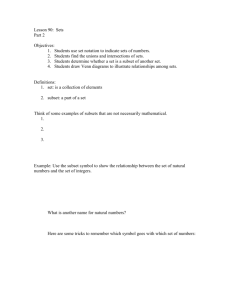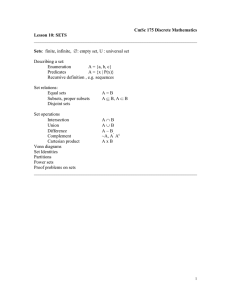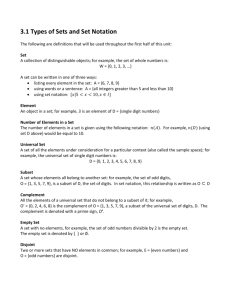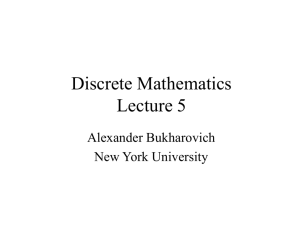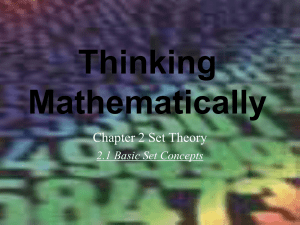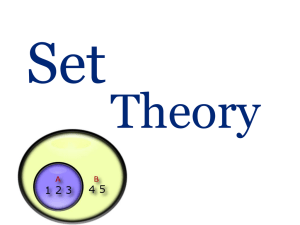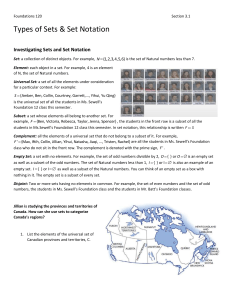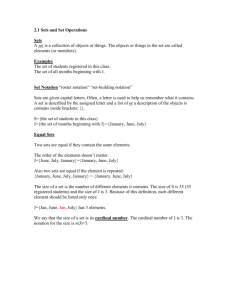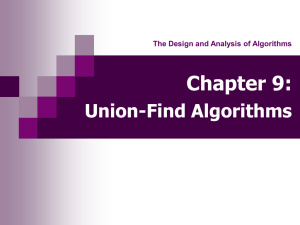SETS
advertisement
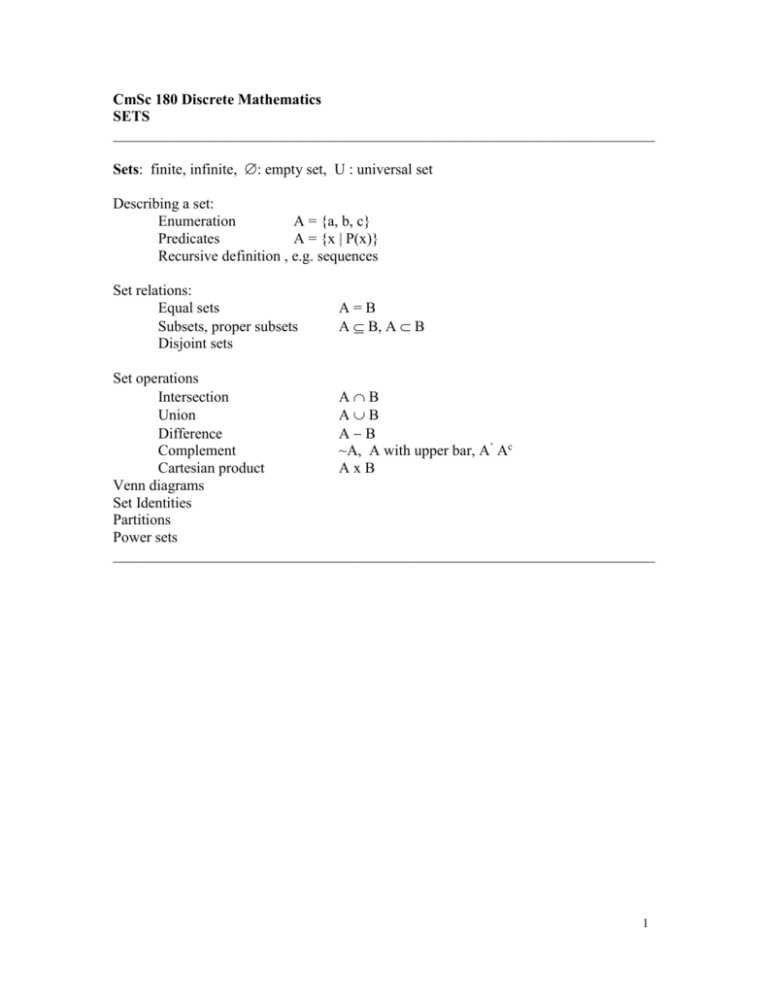
CmSc 180 Discrete Mathematics
SETS
________________________________________________________________________
Sets: finite, infinite, : empty set, U : universal set
Describing a set:
Enumeration
A = {a, b, c}
Predicates
A = {x | P(x)}
Recursive definition , e.g. sequences
Set relations:
Equal sets
Subsets, proper subsets
Disjoint sets
A=B
A B, A B
Set operations
Intersection
AB
Union
AB
Difference
AB
Complement
~A, A with upper bar, A’ Ac
Cartesian product
AxB
Venn diagrams
Set Identities
Partitions
Power sets
________________________________________________________________________
1
1. Introduction
Set: any collection of objects
Naming sets: A, B, C,….
Members of a set: the objects in the set
Naming objects: a, b, c, ….
Notation: Let A be a set of 3 letters a, b, c.
We write A = {a, b, c}
a is a member of A, a is in A, we write a є A
d is not a member of A, we write d A
Important:
1. {a} a
{a} - a set consisting of one element a.
a - the element itself
2. A set can be a member of another set:
B = { 1, 2, {1}, {2}, {1,2}}
Finite sets: finite number of elements
Infinite sets: infinite number of elements
Cardinality of a finite set A: the number of elements in A, notation: #A, or |A|
Cardinality of an infinite set – to be studied in upper-level courses
Describing sets:
a. by enumerating the elements of A:
for finite sets: {red, blue, yellow}, {1,2,3,4,5,6,7,8,9,0}
for infinite sets we write: {1,2,3,4,5,….}
b. by property, using predicate logic notation
Let P(x) is a property, D - universe of discourse
The set of all objects in D, for which P(x) is true, is :
A = {x | P(x)}
we read: A consists of all objects x in D such that P(x) is true
c. by recursive definition, e.g. sequences
2
Examples:
1. The set of the days of the week:
{Sunday, Monday, Tuesday, Wednesday, Thursday, Friday, Saturday}
2. The set of all even positive numbers :
{ x | x > 0 even(x) } = { 2,4,6,8,….}
3. The set of all even numbers, greater than 100:
{ x | even(x) x > 100} = { 102, 104, 106, 108,….}
4. The set of odd positive integers defined recursively as follows:
a1 = 1, an+1 = an + 2 (the odd natural numbers)
Universal set:
Empty set:
U - the set of all objects under consideration
Ø - the set without elements.
2. Relations between sets
2.1. Equality
Let A and B be two sets.
We say that A is equal to B, A = B if and only if they have the same members.
Example:
A = {2,4,6}, B = {2,4,6} A = B
A = {a, b, c}, B = {c, a, b} A = B
A = {1,2,3}, B = {1,3,5}, A ≠ B
Written in predicate notation:
A = B if and only if x (x є A ↔ x є B)
3
2.2. Subsets
The set of all numbers contains the set of all positive numbers. We say that the set of all
positive numbers is a subset of the set of all numbers.
Definition: A is a subset of B if all elements of A are in B. However B may contain
elements that are not in A
Notation: A B
Formal definition:
A B if and only if x ( x є A x є B)
Example: A = {2,4,6}, B = {1,2,3,4,5,6}, A B
Definition: if A is a subset of B, B is called a superset of A.
Other definitions and properties:
a. If A B and B A then A = B
If A is a subset of B, and B is a subset of A, A and B are equal.
b. Proper subsets: A is a proper subset of B, A B, if and only if A is a subset of B and
there is at least one element in B that is not in A.
A B iff x ( x є A x є B) and x (x є B x A)
iff means if and only if
The empty set Ø is a subset of all sets.
All sets are subsets of the universal set U.
4
2.3. Disjoint sets
Definition: Two sets A and B are disjoint if and only if they have no common elements
A and B are disjoint if and only if
i.e. x ( x A V x B)
~x( (x є A ) (x є B))
If two sets are not disjoint they have common elements.
Picturing sets Venn diagrams - used to represent relations between sets
B
A
A is a (proper) subset of B
All elements in the set A are also
elements in the set B
Disjoint sets
A
B
A
B
Not disjoint sets
5
3. Operations on sets
3.1. Intersections
The set of all students in Simpson and the set of all majors in CS have some elements in
common - the set of all students in Simpson, that are majoring in CS. This set is formed
as the intersection of all students in CS and all students in Simpson.
Definition: Let A and B be two sets. The set of all elements common to A and B is called
the intersection of A and B
Notation: A B
Formal definition:
A B = {x | (x є A ) (x є B)}
Venn diagram:
B
A
Example: A = {2,4,6}, B = {1,2,5,6}, A B = {2,6}
Other properties:
A B
A,
A B B
The intersection of two sets A and B is a subset of A, and a subset of B
A Ø = Ø The intersection of any set A with the empty set is the empty set
A U = A The intersection of any set A with the universal set is the set A itself.
Intersection corresponds to conjunction in logic.
Let A = {x | P(x)}, B = {x | Q(x)}
A B = {x | P(x) Q(x)}
6
3. 2. Unions
The set of all rational numbers and the set of all irrational numbers taken together form
the set of all real numbers - as a union of the rational and irrational numbers.
All classes in Simpson consist of students. If we take the elements of all classes, we will
get all students - as the union of all classes.
Definition: The union of two sets A and B consists of all elements that are in A
combined with all elements that are in B.
(note that an element may belong both to A and B)
Notation: A B
Formal definition:
A B = {x | (x є A) V (x є B)}
Venn diagram:
B
A
U
Example: A = {2,4,6,8,10}, B = {1,2,3,4,5,6}, A B = { 1,2,3,4,5,6,8,10}
A B contains all elements in A and B without repetitions.
Other properties of unions:
A
A B
B AB
A is a subset of the union of A and B,
B is a subset of the union of A and B
A Ø = A The union of any set A with the empty set is A
A U = U The union of any set A with the universal set U is the universal set.
Union corresponds to disjunction in logic.
Let A = {x | P(x)}, B = {x | Q(x)}
A B = {x | P(x) V Q(x)}
7
3.3. Differences
The books I have at home are the books that are mine and the books I've taken from the
library. When I return the books to the library, only my own books will remain.
Thus my own books at home form a set that is the difference between all books at home
and library books
Definition: Let A and B be two sets. The set A - B, called the difference between A and
B, is the set of all elements that are in A and are not in B.
Notation: A - B or A \ B
Formal definition:
A - B = { x | ( x є A) ( x B)}
Venn diagram:
A
Example: A = {2,4,6}, B = {1, 5,6},
A-Ø=A
A -U=Ø
B
A - B = {2,4}
The difference between A and the empty set is A
The difference between A and the universal set is the empty set.
3.4. Complements
Definition: Let A be a set. The set of all objects within the universal set that are not in A,
is called the complement of A.
Notation: ~A, A ', Ac
Formal definition:
~ A = {x | x A }
Venn diagram:
A
~A
8
4. Basic set identities
A ~A = U
A ~A = Ø
Complementation Law
Exclusion Law
A U =A
A Ø= A
Identity Laws
A U =U
A Ø=Ø
Domination Laws
A U =U
A A =A
Idempotent Laws
~(~A) = A
Double Complementation Law
A B=BA
A B=BA
Commutative Laws
(A B) C = A ( B C)
Associative Laws
(A B) C = A ( B C)
A (B C) = (A B) (A C)
A (B C) = (A B) (A C)
Distributive Laws
~(A B) = ~A ~B
~(A B) = ~A ~B
De Morgan's Laws
A - B = A ~B
Alternate representation for set difference
Problem: Prove that A (~ A B ) = A B using the basic set identities
9
Problems on set operations
1. Let A = {1,3,4,5}, B = {3,5,7,8}
AB=
AB=
A-B=
Let E = {1, 2, 3, 4, 5, 6, 7, 8, 9, 0}
~A =
~B =
2. Let the universal set be the set R of all real numbers and let
A = {x R | -5 x < 3}, B = { x R | -1 < x 9}.
Find each of the following:
AB=
AB=
~A
=
~B
=
~A ~B =
~A ~B =
~(A B) =
~(A B) =
3. Let U be the set of all students in Simpson College.
A: all CS majors
B: all Math majors
C: all female students
D: all senior students.
Write the expressions for:
a. All female students that are both CS and Math majors
b. All male students and all Math senior students.
c. All CS students that are not senior students
10
Venn diagrams
4. Let A, B and C are sets represented below:
Shade the regions corresponding to:
(A B) C
A (B C)
A - (B C)
~(A B)
11
